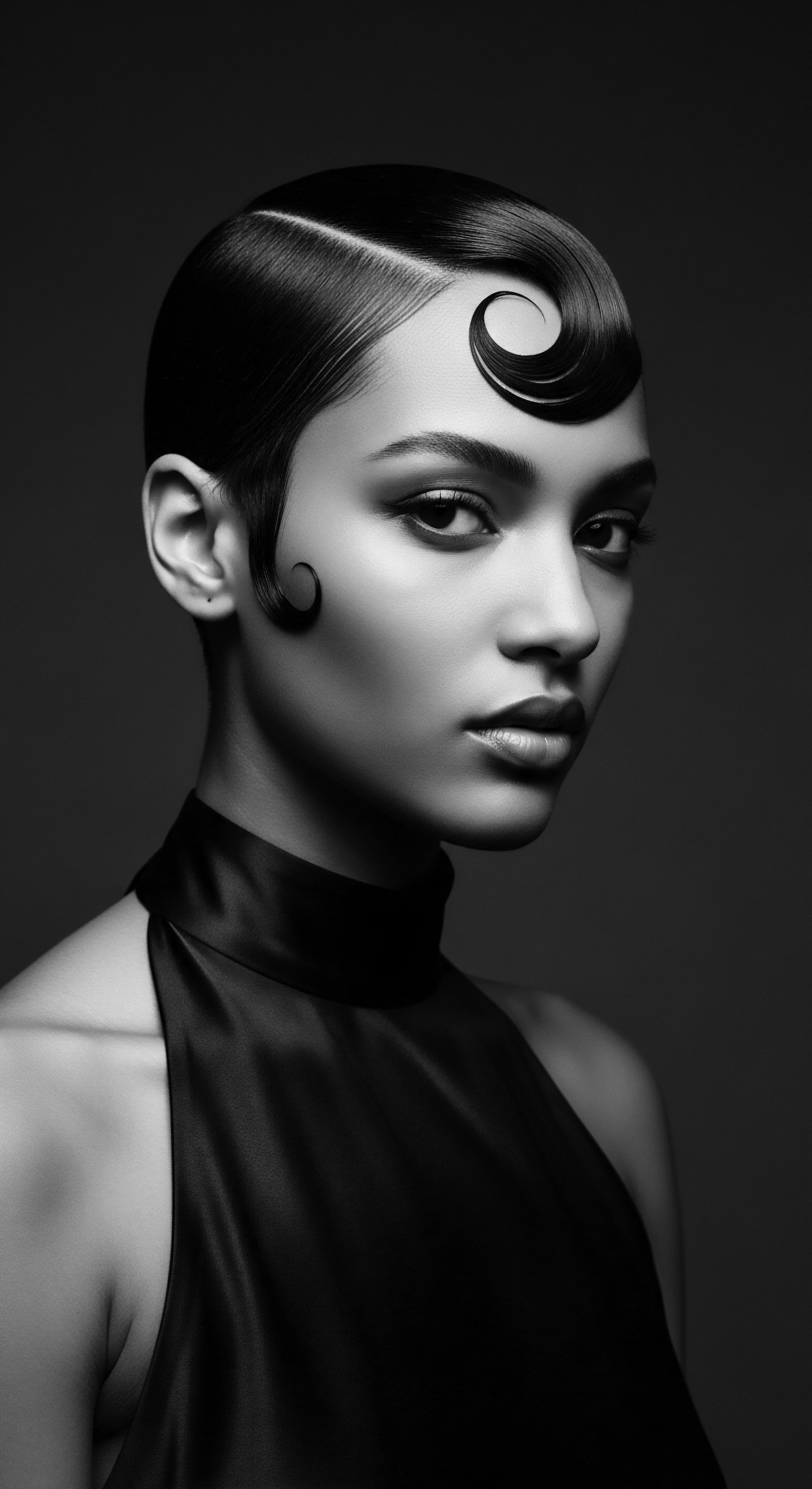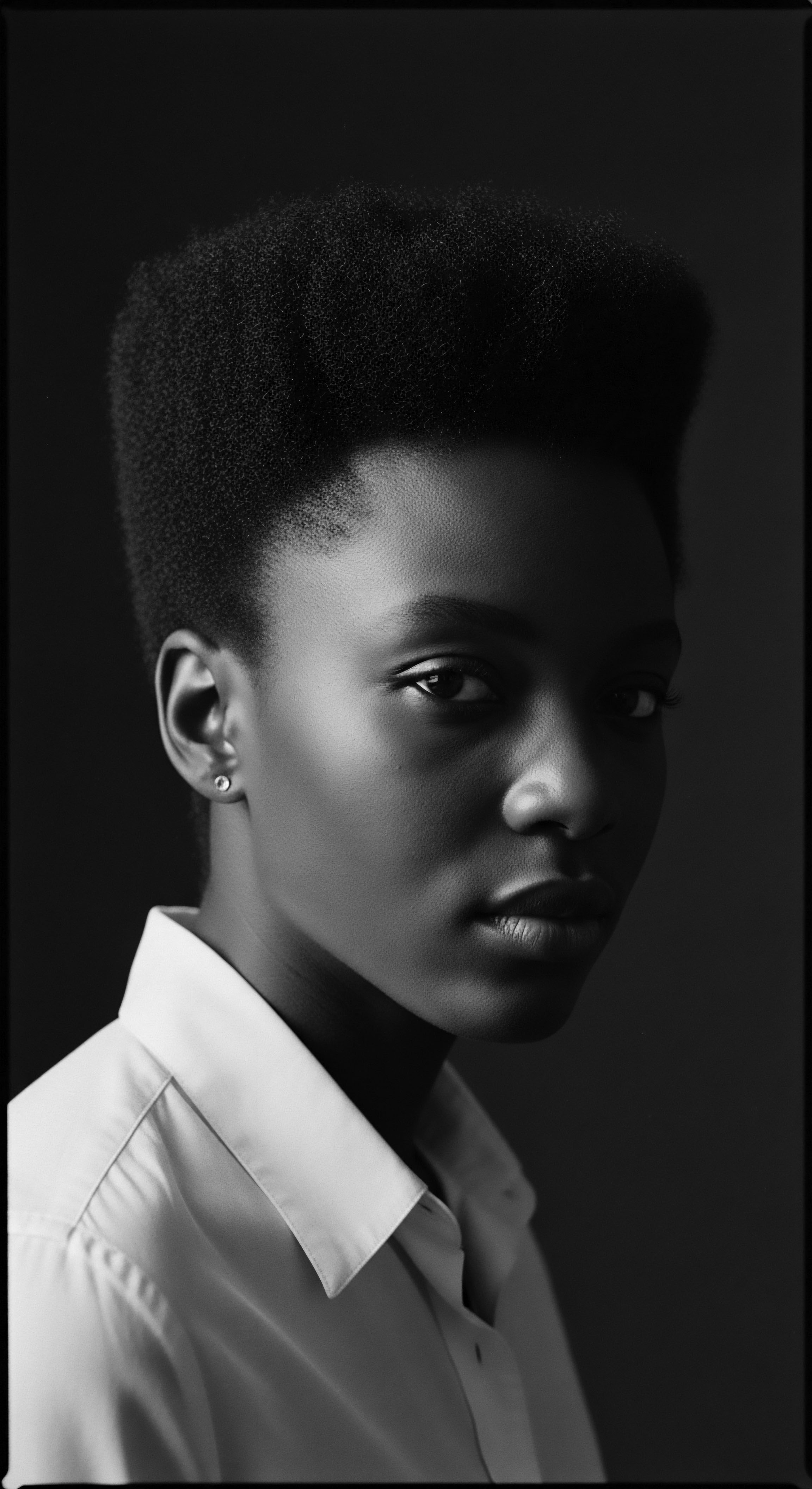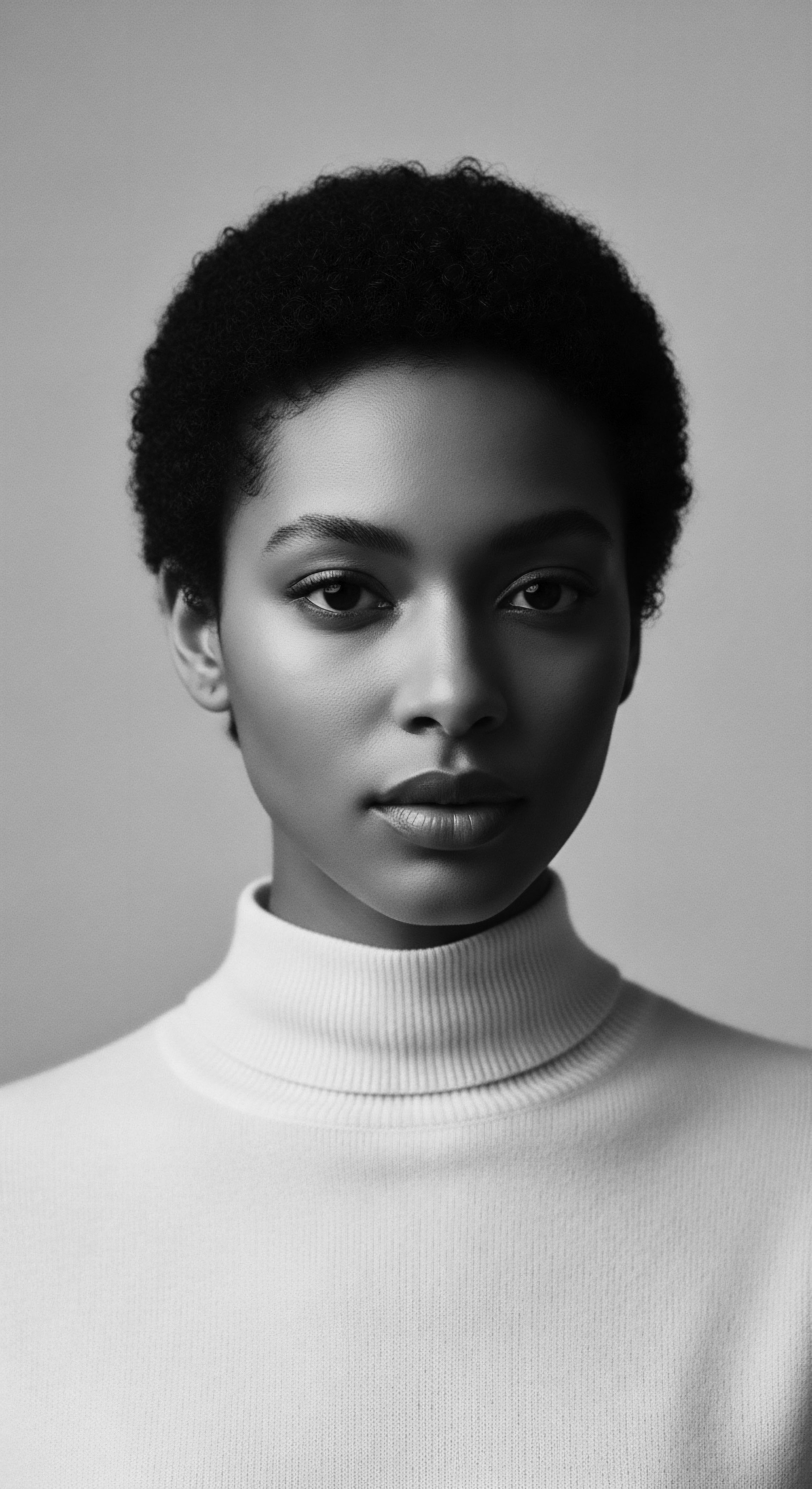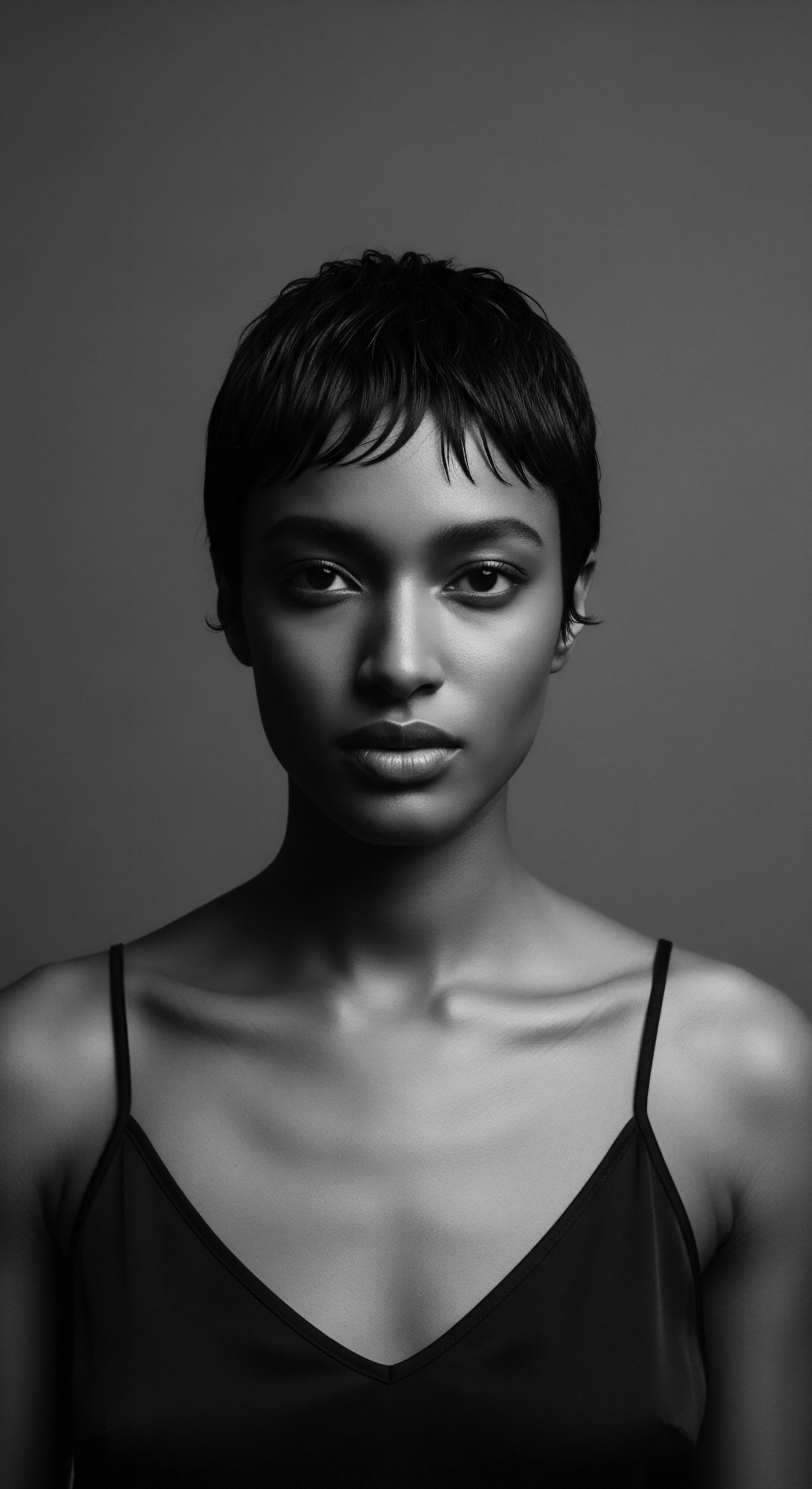
Roots
The very strands that crown our heads, particularly those blessed with coils and curls, whisper stories centuries old. They carry not merely genetic codes, but the echoes of ancestral resilience, practices born of necessity, and wisdom passed through generations. To truly understand the unique care textured hair demands, we must first listen to these whispers, tracing the biological blueprint back to its origins.
It is not merely a matter of surface aesthetics; it is a profound connection to an inherited legacy, a living archive residing within each helix. We embark upon a journey to unearth the foundational understanding of textured hair, recognizing how its intricate biology is inseparable from the heritage that has shaped its preservation and adornment for millennia.

What Defines the Architecture of Textured Hair?
The distinct nature of textured hair begins at its very core, within the scalp’s hidden depths. Unlike the straight or wavy hair found across other populations, Afro-textured hair emerges from an elliptically shaped follicle, not round. This follicle is not straight either; instead, it exhibits a striking S-shaped or curved configuration beneath the skin. This curvature of the follicle is the primary architect of the hair’s eventual coil, determining its tightly spiraled path as it grows.
Imagine a long ribbon, when pulled through a spiraled tube, it will inevitably twist upon itself. This is the biological ballet of textured hair formation.
Beyond the follicle’s shape, the hair shaft itself displays a flattened, elliptical cross-section, which can vary along its length. This contrasts sharply with the more cylindrical cross-section of Asian hair or the round to oval shape of Caucasian hair. These structural peculiarities mean the internal cells of the hair shaft, particularly the cortical cells, are distributed unevenly, leading to a bilateral asymmetry within the fiber.
This uneven cellular distribution, alongside the hair’s inherent curvature, creates points of weakness and shear forces within the strand itself. When the hair is manipulated—combed, brushed, or even just stretched—these internal stresses can initiate cracks within the cell membrane complex between cortical cells or between the cuticle and cortex, leading to breakage.

How Does Keratinization Shape Coil Patterns?
Hair is primarily composed of Keratin, a strong protein, and the process by which hair cells fill with this protein is called keratinization. In all hair types, cells produced by the hair bulb are pushed upwards, dying as they fill with keratin to form the visible hair shaft. However, the unique geometry of the textured hair follicle influences how this keratinization occurs. The process of cytodifferentiation, where keratinocytes mature into hardened, protein-filled cells, is affected by the curved path they travel.
While the basic chemical composition of keratin is similar across different hair types, the way these keratin proteins are arranged and cross-linked can vary. Afro-textured hair often exhibits a higher density of disulfide bonds, which are the chemical links that contribute to the hair’s shape and strength. This high density of bonds, coupled with the spiral growth, contributes to its distinct coiled structure. The distribution of lipids also plays a role in modifying the arrangement of keratin fibers, influencing the hair’s morphology.
The fundamental biology of textured hair, from its S-shaped follicle to its elliptical shaft, creates an inherent predisposition for specific care needs.

What is the Hair’s Protective Outer Layer?
The outermost layer of the hair shaft is the Cuticle, acting as a protective shield for the inner cortex. Composed of overlapping scales, similar to shingles on a roof, the cuticle’s integrity is paramount for moisture retention and protection. In textured hair, these cuticle layers tend to be fewer in number compared to Asian hair, which can have more than 12 layers, or Caucasian hair, which typically has 4 to 7. Afro-textured hair generally possesses 8 to 12 cuticle layers.
Furthermore, the coiled nature of textured hair can cause these cuticle scales to be naturally raised or unevenly arranged. This raised configuration means the cuticle is less able to lie completely flat, creating surfaces more susceptible to friction and environmental damage. When friction occurs, these already raised cuticles can lift further, leading to frizz, split ends, and breakage. This anatomical reality directly correlates with the historical emphasis on low-manipulation styling and protective practices in many ancestral hair care traditions.

How Does Moisture Retention Differ for Coils?
Despite popular assumptions, Afro-textured hair actually has a higher overall lipid content than European and Asian hair, sometimes 2.5 to 3.2 times greater. It also possesses a higher internal lipid content, approximately 1.7 times more than other ethnic groups. These lipids, including free fatty acids, sterols, and polar lipids, are crucial for maintaining hair integrity, hydrophobicity, and moisture. However, the distribution of these lipids differs; while sebaceous lipids (from the scalp’s oil glands) predominantly contribute to Afro-textured hair, internal lipids are more pronounced in European and Asian hair, contributing to their moisture retention and UV resistance.
The challenge for textured hair lies not in a lack of lipids, but in their distribution and the hair’s unique structure. The tight coils and twists of textured hair impede the smooth downward travel of natural oils (sebum) from the scalp along the entire hair shaft. This uneven distribution leaves the lengths and ends of the hair prone to dryness, despite the scalp potentially feeling oily. This inherent dryness contributes significantly to its susceptibility to breakage, as dry hair is more fragile and less pliable.
The biomechanical characteristics of textured hair, specifically its curvature, create areas of weakness that make it more vulnerable to damage and breakage, even though it is not intrinsically weaker than other hair types. The relative inability of coiled hair to retain hydration effectively, despite its lipid composition, underscores the persistent need for external moisture and conditioning in its care.

Ritual
The journey into textured hair’s unique care needs extends beyond mere biology. It leads us into the realm of ritual, of practices honed over centuries that speak to a profound understanding of the hair’s delicate nature and its sacred place within cultural identity. From the ancient traditions of Africa to the resilient adaptations across the diaspora, these rituals were not incidental; they were direct responses to the biological realities of coiled strands, shaped by deep historical and communal wisdom.

Why Were Protective Styles Historically Valued?
The historical practice of protective styling in African communities was a direct, intuitive response to the biological fragility of textured hair. Knowing that hair breakage occurs more readily when strands are manipulated or exposed to environmental stressors, ancestral communities developed intricate methods to minimize such occurrences. Braiding, twisting, and coiling were not simply aesthetic choices; they were strategies to preserve hair length, protect delicate ends, and maintain the hair’s integrity.
For instance, ancient Egyptian civilizations, known for their meticulous grooming, wore elaborate wigs and intricate braids, often adorned with precious materials, signifying wealth and spiritual devotion. These styles, whether wigs or natural hair formations, inherently offered a layer of protection from the harsh elements, a practical benefit often overlooked in purely aesthetic interpretations. West African cultures employed complex braiding patterns that communicated social status, age, marital status, and even spiritual beliefs.
The act of braiding itself was, and remains, a communal activity, fostering deep social bonds as women gathered to tend to each other’s hair. This communal aspect reinforced the longevity of styles, as frequent manipulation was minimized, a key biological benefit for breakage-prone hair.
Ancestral hair practices, particularly protective styling, reveal a deep, intuitive understanding of textured hair’s biological needs for preservation.
One powerful historical example of ancestral hair care practices is the use of Chebe Powder by the Basara Arab women of Chad. For generations, these women have maintained exceptionally long, thick hair, often extending past their waist, through a consistent regimen of applying Chebe powder. This powder, a mix of natural herbs, seeds, and plants native to Chad, is typically mixed with oils or butters and applied to damp, sectioned hair, which is then braided and left for days.
The biological reason for Chebe powder’s effectiveness lies in its ability to seal the hair shaft, thus retaining moisture and preventing breakage, rather than directly stimulating hair growth. This practice directly addresses the inherent dryness and breakage susceptibility of coiled and kinky hair types by locking in hydration and strengthening the hair shaft. It provides a protective coating that mitigates the effects of friction and environmental exposure, allowing the hair to retain length over time.
(Rovang, 2024). This rigorous, ancestral practice serves as a testament to the sophisticated understanding of hair biology that existed long before modern scientific inquiry.

How Do Traditional Ingredients Aid Hair Health?
The wealth of ancestral hair care is rooted in the earth’s bounty, a testament to the intuitive wisdom of Indigenous communities regarding natural ingredients. Many African communities utilized local botanicals, oils, and butters, understanding their inherent properties long before chemical analyses confirmed their benefits.
- Shea Butter (Vitellaria paradoxa) from the Shea tree, revered as “The Sacred Tree of the Savannah,” has been a cornerstone. Its emollient properties deeply hydrate the hair shaft, reinforcing strands and relieving dryness. Its use dates back to Queen Cleopatra’s reign, highlighting its ancient legacy.
- Coconut Oil and Aloe Vera were also widely used to nourish and protect hair, prioritizing moisture and scalp health.
- The practice of mixing powders like Chebe with animal milk or whipped butters, as seen in Ethiopian and Somali traditions, points to an understanding of lipid-rich applications for moisture and strength.
These natural ingredients, often rich in lipids, help to smooth the hair cuticle and minimize moisture loss, addressing the specific challenges of coiled hair where natural oils struggle to travel down the shaft. Their consistent use formed the basis of routines designed to counteract dryness and maintain the hair’s suppleness, directly supporting its biological need for constant hydration.
| Historical Practices (Heritage) Braiding and wrapping hair to minimize manipulation and exposure. |
| Contemporary Scientific Understanding (What is the Biological Reason for Textured Hair’s Unique Care Needs?) Reduces mechanical stress and friction, preventing damage to the fragile cuticle and cortical cells. |
| Historical Practices (Heritage) Using plant-based oils and butters (e.g. Shea butter, Chebe powder infusions). |
| Contemporary Scientific Understanding (What is the Biological Reason for Textured Hair’s Unique Care Needs?) Replenishes external lipids, reinforces the hair's protective barrier, and seals in hydration, addressing the challenge of sebum distribution. |
| Historical Practices (Heritage) Communal hair grooming as a bonding and knowledge-sharing activity. |
| Contemporary Scientific Understanding (What is the Biological Reason for Textured Hair’s Unique Care Needs?) Encourages consistent care practices and the transmission of effective, low-manipulation techniques. |
| Historical Practices (Heritage) Nighttime hair coverings (e.g. headwraps, bonnets). |
| Contemporary Scientific Understanding (What is the Biological Reason for Textured Hair’s Unique Care Needs?) Protects hair from friction with bedding, preserving moisture and preventing tangles and breakage while sleeping. |
| Historical Practices (Heritage) The enduring wisdom of ancestral hair care practices directly corresponds with modern scientific understanding of textured hair's biological needs, forming a seamless continuum of heritage and science. |

Relay
The narrative of textured hair care stretches across generations, a living relay of knowledge, adaptation, and affirmation. This segment moves beyond fundamental structures and practices, delving into the intricate interplay between biology, heritage, and the evolving challenges and triumphs of textured hair communities globally. We consider how scientific insights affirm ancestral wisdom and how the very act of care reinforces identity through the lens of history.

How Do Environmental and Genetic Factors Influence Hair Health?
Hair health is a complex interplay of intrinsic biological factors and extrinsic environmental influences. For textured hair, this dynamic is particularly relevant. The slower growth rate of African hair, approximately 70-75% compared to other ethnicities, combined with a higher proportion of hair fibers in the resting (telogen) phase, means it spends less time in active growth. This biological rhythm contributes to a perception of less length retention, making careful preservation even more significant.
Moreover, textured hair’s unique morphology, with its elliptical cross-section and points of weakness, renders it more susceptible to damage from external factors. Mechanical stress, such as aggressive detangling or styling, can cause cracks to form within the hair shaft, leading to breakage. Environmental factors, including dry climates or harsh styling chemicals, exacerbate moisture loss, further compromising the hair’s integrity.
The historical context of forced assimilation during slavery, where traditional tools and natural methods were stripped away, meant enslaved Africans had to adapt, sometimes resorting to practices that caused damage, simply to survive. Yet, even in these dire circumstances, the practice of braiding persisted as a quiet act of resistance and preservation of African identity, underscoring the deep connection between hair care and heritage.

What Are the Biological Implications of Nighttime Hair Protection?
The practice of covering hair at night, ubiquitous among Black women, is more than a cultural ritual; it is a biologically informed strategy for preserving hair health. Historically, this practice was passed down through generations, often involving bonnets, silk scarves, or other fabric coverings. The purpose was clear ❉ to protect hair from friction with bedding, maintain moisture, and preserve hairstyles.
From a biological perspective, cotton pillowcases and bedding materials absorb moisture from the hair, leading to dryness and brittleness. The coiled structure of textured hair means its cuticle layers can be slightly raised, making them particularly vulnerable to friction. When hair rubs against rough surfaces like cotton, these raised cuticles can become further lifted or damaged, resulting in frizz, tangles, and breakage.
Silk or satin coverings provide a smooth surface, minimizing friction and allowing the hair’s natural oils and applied moisture to remain on the strands. This protection is especially relevant for textured hair, which already struggles with the even distribution of sebum and maintaining hydration along the shaft.
This nighttime ritual, therefore, is a testament to an ancestral understanding of hair physiology, translating into practices that directly mitigate biological vulnerabilities. The Tignon Laws, enacted in Louisiana in 1786, forced free Black women to wear headscarves (tignons) in an attempt to diminish their beauty and social standing. Yet, these coverings, originally a tool of oppression, were re-appropriated and transformed into symbols of pride, resistance, and self-expression, further cementing the dual nature of hair care as both biological necessity and cultural statement.

How Do Holistic Influences Shape Hair Health and Heritage?
The concept of holistic well-being, deeply rooted in ancestral African philosophies, extends naturally to hair health. Traditional African communities often viewed hair as sacred, a link to ancestry, spirituality, and identity. Hair rituals were ceremonial acts, passed down through generations, symbolizing connection to the divine, social status, and community belonging. This reverence for hair meant that its care was integrated into a broader framework of wellness, encompassing not just external treatments but also internal nourishment and spiritual connection.
Diet, for example, plays a significant role in hair health. Certain nutrients, like zinc, iron, and folic acid, along with adequate protein and antioxidants, are important for healthy hair growth and preventing breakage. While modern science highlights specific nutrients, ancestral diets, rich in diverse plant foods and traditional ingredients, often provided these elements intuitively.
Furthermore, stress, a modern affliction, is known to contribute to hair loss and breakage by causing hair follicles to go dormant. Ancestral wellness practices often included communal activities, mindful rituals, and connection to nature, which could have inherently mitigated such stressors, contributing to overall health, including hair vitality.
The integration of biological needs, protective styling, and holistic wellness practices forms a complex web of care, profoundly shaped by generations of ancestral wisdom.
The preservation of African hair care practices through the diaspora, despite displacement and oppression, speaks to their deep cultural and biological significance. Hair care became a journey of survival, adaptation, and self-expression for African Americans. The continuity of styles like cornrows, Fulani braids, and Bantu knots, deeply embedded in African history, served as a way to connect with heritage and maintain identity amidst challenging environments. These practices, grounded in biological understanding and cultural meaning, continue to empower individuals to honor their lineage and celebrate their inherent beauty.
- Communal Braiding ❉ This practice, widespread across African cultures, fosters social bonds and serves as a vehicle for storytelling and knowledge transmission. It also ensures consistent, gentle manipulation, supporting hair health.
- Traditional Oils and Butters ❉ Ingredients like Marula Oil and Baobab Oil, alongside Shea butter, were used to moisturize, protect, and enhance the hair’s natural properties, reflecting a deep understanding of lipid benefits.
- Head Wraps ❉ From their ancient symbolic uses to their protective function during sleep, headwraps are a historical tool for preserving hair moisture and preventing friction damage.

Reflection
The journey into textured hair’s unique care needs culminates not in a single answer, but in a profound recognition of a living, breathing heritage. Each coil, each strand, is a testament to centuries of wisdom—a biological marvel intricately woven with ancestral ingenuity and cultural resilience. Understanding the elliptical follicle, the raised cuticle, and the challenges of moisture distribution is not merely an academic exercise; it is an act of reverence. It is an acknowledgment that the elaborate protective styles, the careful application of rich, natural butters, and the simple act of wrapping one’s hair at night were, and remain, sophisticated responses to intrinsic biological realities.
This knowledge, passed from elder to youth, from continent to diaspora, forms the very Soul of a Strand. It reminds us that care is not a burden, but a legacy. It is a connection to those who, despite immense challenges, ensured the health and dignity of their crowns.
As we embrace contemporary scientific insights, we find they often affirm the practices that have sustained textured hair for ages. This ongoing conversation between ancient wisdom and modern understanding deepens our appreciation for this hair type, moving beyond superficial beauty standards to a place of genuine respect and celebration of its inherent power.

References
- Mbiya, T. A. & Mbiya, H. F. (2024). The Genomic Variation in Textured Hair ❉ Implications in Developing a Holistic Hair Care Routine. MDPI.
- Hair Care Practices from the Diaspora ❉ A Look at Africa, America, and Europe. (2025).
- Mbiya, T. A. & Mbiya, H. F. (2024). The Genomic Variation in Textured Hair ❉ Implications in Developing a Holistic Hair Care Routine. Preprints.org.
- Mbiya, T. A. & Mbiya, H. F. (2024). The Genomic Variation in Textured Hair ❉ Implications in Developing a Holistic Hair Care Routine. ResearchGate.
- Robbins, C. R. & Bhushan, B. (2020). Defying Damage ❉ Understanding Breakage in Afro-textured Hair. Cosmetics & Toiletries.
- Lumen Learning. (n.d.). Hair | Biology for Majors II.
- Wilderness. (2015). The history & meaning of head wraps across Africa.
- Estherotomi. (2015). BLACK HAIR SCIENCE ❉ THE STRUCTURE OF AFRO TEXTURED HAIR.
- Williams, M. (2021). How a Hair Wrap Routine Protects More Than Just My Hair. Sleep.com.
- Nyela, O. (2021). Braided Archives ❉ Black hair as a site of diasporic transindividuation. YorkSpace.
- Black Afro Hair. (2013). THE SCIENCE OF HAIR – PART ONE (The Basics).
- Nourished Springs. (2024). How does friction affect Afro textured hair?
- Plastic Surgery Key. (2023). Ethnic differences in hair.
- Jackson, S. (2024). How Bonnets Went From Niche Black Beauty Ritual To Mainstream Accessory. The Zoe Report.
- Ancient African Hair Secrets. (2025). The History of Chebe Powder ❉ An Ancient African Hair Secret for Hair Growth.
- Nylahs Naturals. (n.d.). Your Guide To Hair Science And Hair Texture.
- Vashi, N. (2021). Hair aging differs by race, ethnicity. EurekAlert!
- Hype Hair. (2023). Unveiling the History of the Hair Bonnet for Black Women.
- Rovang, D. (2024). Ancient Gems ❉ A Historical Survey of African Beauty Techniques.
- Maymone, M. B. C. Laughter, M. Pollock, S. Khan, I. Marques, T. Abdat, R. Goldberg, L. J. & Vashi, N. A. (2021). Hair Aging in Different Races and Ethnicities. J Clin Aesthet Dermatol.
- AfricanFabs. (n.d.). African Headwraps.
- Happi. (2021). Hair Care Is a Focus in Africa.
- Green Views Residential Project. (2022). History of the African head wrap.
- JDDonline. (n.d.). Hair and Scalp Disorders in Ethnic Populations.
- Leone Culture. (2023). Exploring the Significance Of Headwraps In African Fashion And Traditions.
- Ashro Blog. (2024). African Headwraps 101 ❉ A Powerful Accessory.
- BuyCosmetics.CY. (2025). The Role of Lipids in Hair Masks ❉ Unlocking the Secret to Healthier Hair.
- Khumbula. (2024). A Crowning Glory ❉ Hair as History, Identity, and Ritual.
- Substack. (2025). Ancestral Hair Rituals to Nourish Your Hair and Soul.
- MDedge. (n.d.). Historical Perspectives on Hair Care and Common Styling Practices in Black Women.
- MDedge. (2025). Historical Perspectives on Hair Care and Common Styling Practices in Black Women.
- Afriklens. (2024). African Hairstyles ❉ Cultural Significance and Legacy.
- MDPI. (2023). Hair Lipid Structure ❉ Effect of Surfactants.
- Rovang, D. (2024). Ancient Gems ❉ A Historical Survey of African Beauty Techniques.
- Psi Chi. (n.d.). PsychoHairapy ❉ Brushing Up on the History and Psychology of Black Hair.
- Mount Sinai. (n.d.). Dry hair Information.
- Design Essentials. (n.d.). Hair Composition.
- Morrow, W. (1990). 400 years without a comb ❉ The untold story. Black Publishers.
- Sew Historically. (2015). Night-Time Hair Routine – Victorian And Edwardian Hair Care.
- Reddit. (2021). No raw oils and butters vs. Traditional African hair care?
- BRAZIL-PROF. (2023). Hair treatment with keratin ❉ peculiarities of keratinization to restore strands.
- PubMed Central. (n.d.). Hair Breakage in Patients of African Descent ❉ Role of Dermoscopy.
- Victoria Lett. (2019). Hair as Performance Art & Sacred Ritual for the African Descendant.
- Healthline. (n.d.). Hair Breakage ❉ 12 Possible Causes and Treatment.
- Visible Body. (2022). Let’s Untangle This ❉ All About Hair.
- PubMed Central. (n.d.). Keratinization and its Disorders.
